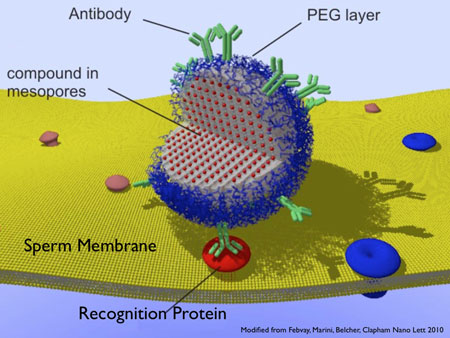 It's found only in the tails of sperm. It takes seven genes to build it. It gets activated as the sperm gets closer to the egg, giving it that extra whip and thrust to make it across the finish line. David Clapham, its discoverer, named it CatSper. Blocking it could literally make sperm impotent. This could be the basis of a new contraceptive gel or a pill that could be used by men or women.
It's found only in the tails of sperm. It takes seven genes to build it. It gets activated as the sperm gets closer to the egg, giving it that extra whip and thrust to make it across the finish line. David Clapham, its discoverer, named it CatSper. Blocking it could literally make sperm impotent. This could be the basis of a new contraceptive gel or a pill that could be used by men or women.
Apr 7th, 2011
Read more
A Stanford research team uses glowing nanopillars to give biologists, neurologists and other researchers a deeper, more precise look into living cells.
Apr 7th, 2011
Read more
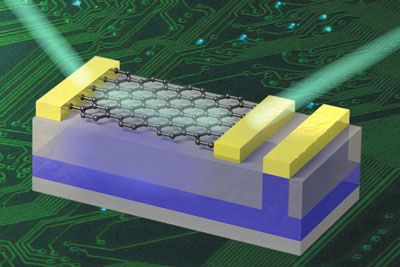 Graphen gilt wegen seiner physikalischen und chemischen Eigenschaften als eines der vielversprechendsten neuen Materialien. Wissenschaftler haben jetzt ein Verfahren entwickelt, das es erlaubt, Bauelemente aus Graphen mithilfe einer integrierten Elektrode gezielt anzusteuern - eine wichtige Voraussetzung fuer industrielle Anwendungen.
Graphen gilt wegen seiner physikalischen und chemischen Eigenschaften als eines der vielversprechendsten neuen Materialien. Wissenschaftler haben jetzt ein Verfahren entwickelt, das es erlaubt, Bauelemente aus Graphen mithilfe einer integrierten Elektrode gezielt anzusteuern - eine wichtige Voraussetzung fuer industrielle Anwendungen.
Apr 7th, 2011
Read more
This online workshop on 'Nanomaterials for Biological Applications' will enable participants to meet and find out about each other's expertise and research interests in this field.
Apr 7th, 2011
Read more
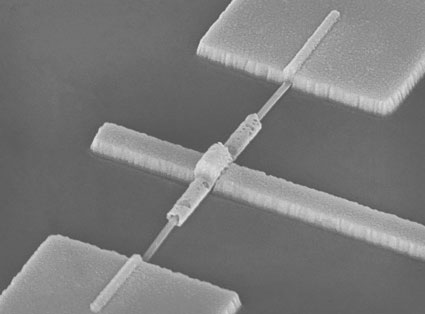 In an interesting feat of nanoscale engineering, researchers at Lund University in Sweden and the University of New South Wales have made the first nanowire transistor featuring a concentric metal 'wrap-gate' that sits horizontally on a silicon substrate.
In an interesting feat of nanoscale engineering, researchers at Lund University in Sweden and the University of New South Wales have made the first nanowire transistor featuring a concentric metal 'wrap-gate' that sits horizontally on a silicon substrate.
Apr 7th, 2011
Read more
The arrays of fine adhesive hairs or 'setae' on the foot pads of many insects, lizards and spiders give them the ability to climb almost any natural surface. Research by James Bullock and Walter Federle from the University of Cambridge in England found that the different forces required to peel away these adhesive hairs from surfaces are what allows beetles to adhere to diverse surfaces, thereby reducing the risk of detachment.
Apr 7th, 2011
Read more
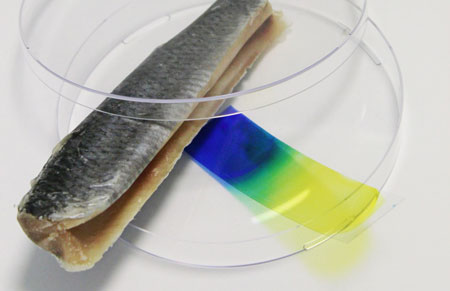 When it comes to packaged fish or meat, it is nearly impossible to distinguish between fresh goods and their inedible counterparts. Researchers have now developed a sensor film that can be integrated into the package itself, where it takes over the role of quality control. And if the food has spoiled, it changes color to announce the fact.
When it comes to packaged fish or meat, it is nearly impossible to distinguish between fresh goods and their inedible counterparts. Researchers have now developed a sensor film that can be integrated into the package itself, where it takes over the role of quality control. And if the food has spoiled, it changes color to announce the fact.
Apr 7th, 2011
Read more
Elsevier, a world-leading publisher of scientific, technical and medical information products and services, today announced the launch of the "Apps for Science" challenge, an international competition challenging software developers to create customized applications that enhance information search and discovery for researchers.
Apr 7th, 2011
Read more
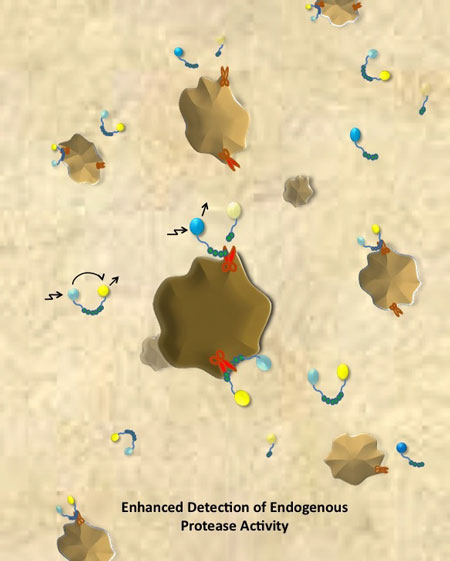 Chemical engineers at UC Santa Barbara expect that their new process to create molecular probes may eventually result in the development of new drugs to treat cancer and other illnesses.
Chemical engineers at UC Santa Barbara expect that their new process to create molecular probes may eventually result in the development of new drugs to treat cancer and other illnesses.
Apr 6th, 2011
Read more
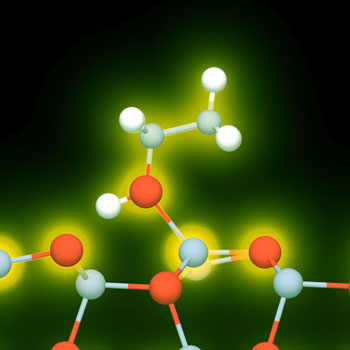 Unlike many conventional chemical detectors that require an external power source, Lawrence Livermore researchers have developed a nanosensor that relies on semiconductor nanowires, rather than traditional batteries. The device overcomes the power requirement of traditional sensors and is simple, highly sensitive and can detect various molecules quickly.
Unlike many conventional chemical detectors that require an external power source, Lawrence Livermore researchers have developed a nanosensor that relies on semiconductor nanowires, rather than traditional batteries. The device overcomes the power requirement of traditional sensors and is simple, highly sensitive and can detect various molecules quickly.
Apr 6th, 2011
Read more
A consortium formed by Brown University and the University of Rhode Island has invited industry leaders to explore partnerships and the job-creating potential of nanotechnology, a cutting-edge branch of science that has produced materials found in products from cosmetics to computer chips.
Apr 6th, 2011
Read more
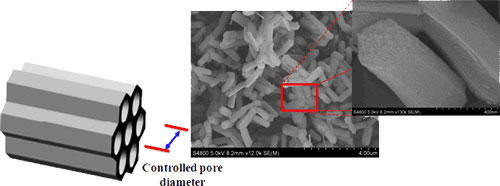 Researchers at Rensselaer Polytechnic Institute discover new method to boost enzymatic activity.
Researchers at Rensselaer Polytechnic Institute discover new method to boost enzymatic activity.
Apr 6th, 2011
Read more
Prof. Mathias Klaeui from the SwissFEL, Paul Scherrer Institut and the Laboratory of Nanomagnetism and Spin Dynamics, EPFL, is the 2011 recipient of the Nicholas Kurti European Science Prize.
Apr 6th, 2011
Read more
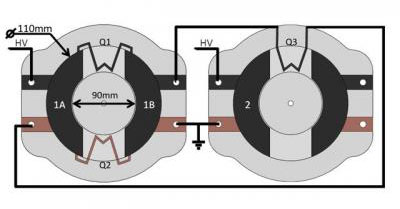 Battery technology hasn't kept pace with advancements in portable electronics, but the race is on to fix this. One revolutionary concept being pursued by a team of researchers in New Zealand involves creating "wearable energy harvesters" capable of converting movement from humans or found in nature into battery power.
Battery technology hasn't kept pace with advancements in portable electronics, but the race is on to fix this. One revolutionary concept being pursued by a team of researchers in New Zealand involves creating "wearable energy harvesters" capable of converting movement from humans or found in nature into battery power.
Apr 6th, 2011
Read more
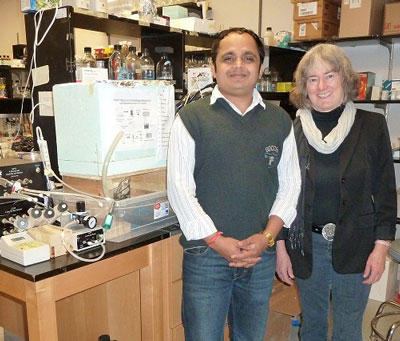 Queen's researchers have discovered that nanoparticles, which are now present in everything from socks to salad dressing and suntan lotion, may have irreparably damaging effects on soil systems and the environment.
Queen's researchers have discovered that nanoparticles, which are now present in everything from socks to salad dressing and suntan lotion, may have irreparably damaging effects on soil systems and the environment.
Apr 6th, 2011
Read more
 Argonne scientist Yugang Sun has been recognized as the one of the five top materials scientists in the world over the past decade, according to a new ranking recently released by Thomson Reuters.
Argonne scientist Yugang Sun has been recognized as the one of the five top materials scientists in the world over the past decade, according to a new ranking recently released by Thomson Reuters.
Apr 6th, 2011
Read more
 It's found only in the tails of sperm. It takes seven genes to build it. It gets activated as the sperm gets closer to the egg, giving it that extra whip and thrust to make it across the finish line. David Clapham, its discoverer, named it CatSper. Blocking it could literally make sperm impotent. This could be the basis of a new contraceptive gel or a pill that could be used by men or women.
It's found only in the tails of sperm. It takes seven genes to build it. It gets activated as the sperm gets closer to the egg, giving it that extra whip and thrust to make it across the finish line. David Clapham, its discoverer, named it CatSper. Blocking it could literally make sperm impotent. This could be the basis of a new contraceptive gel or a pill that could be used by men or women. 









 Subscribe to our Nanotechnology News feed
Subscribe to our Nanotechnology News feed